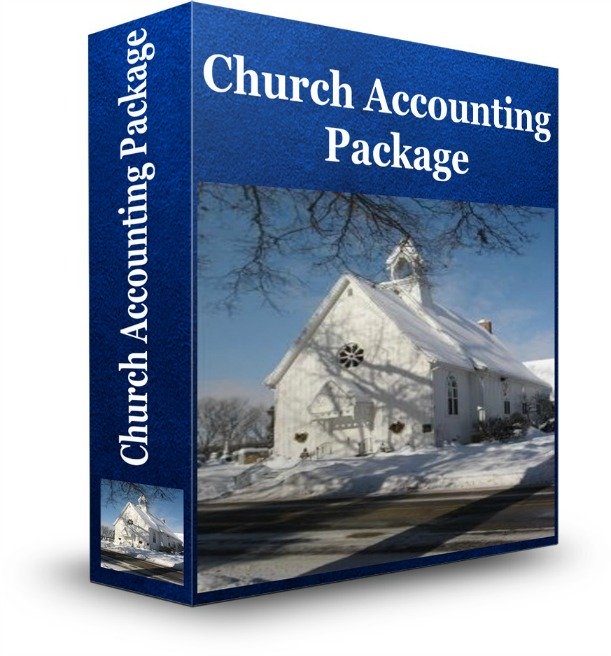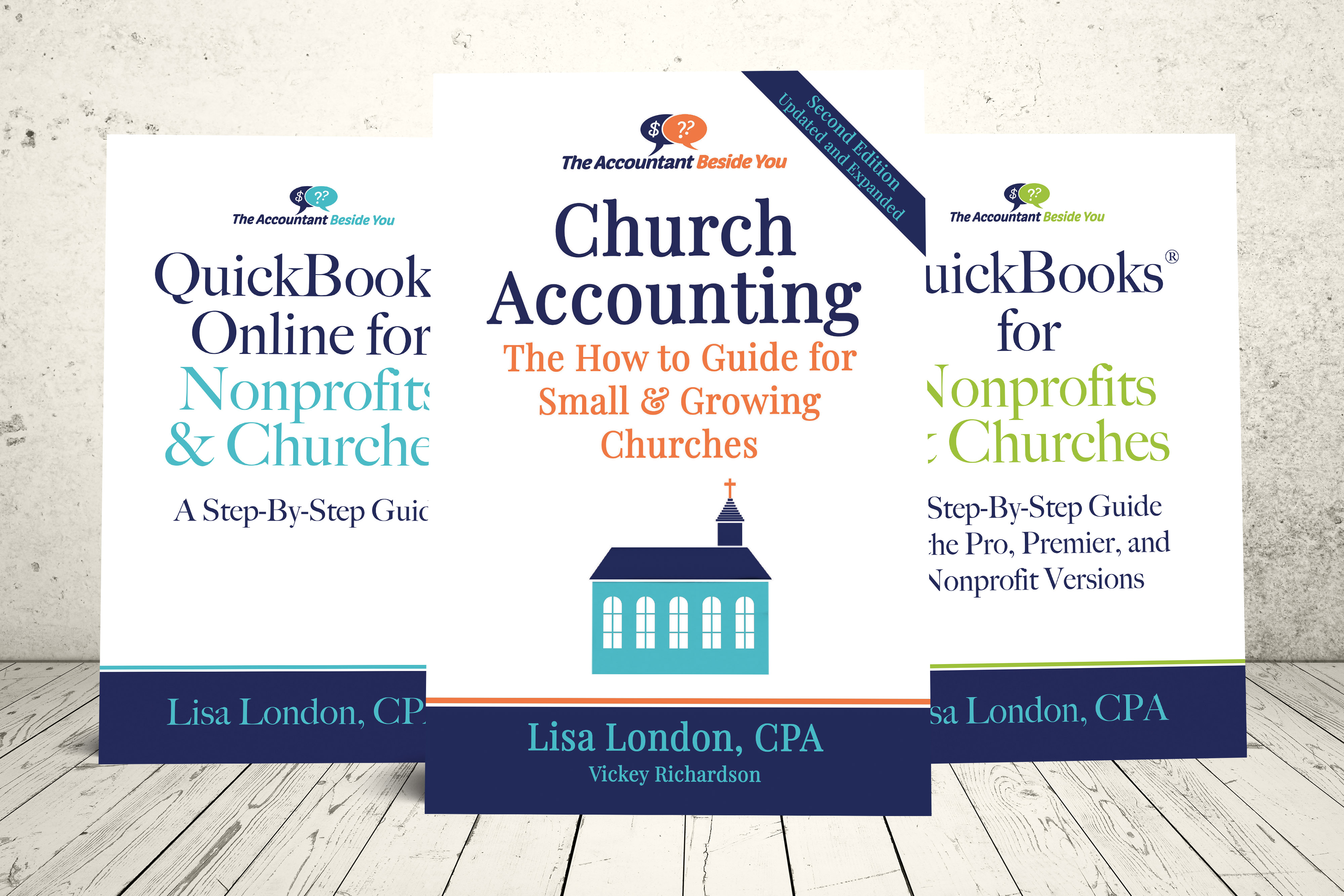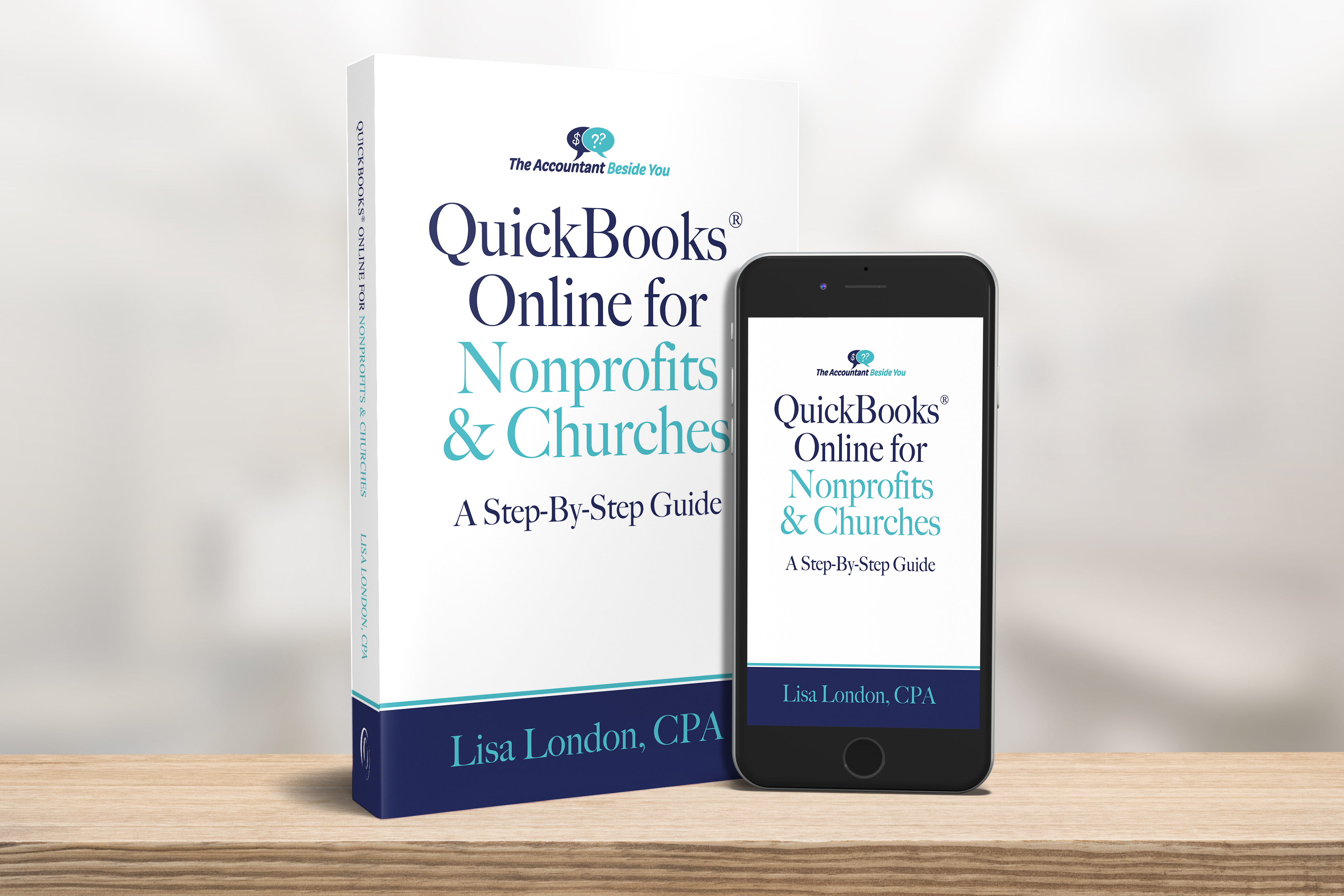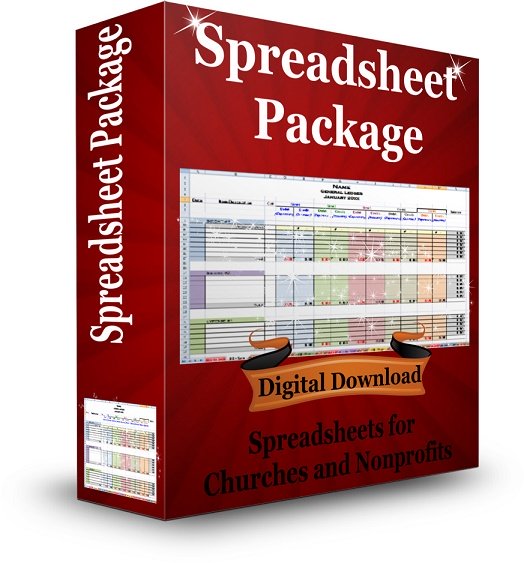Fund Accounting Basics
Method of Accounting for Nonprofits and Churches
Fund accounting is an accounting method that groups assets and liabilities according to the specific purpose for which they are to be used It keeps restricted and unrestricted funds separate for churches and nonprofits.

Coupon!
Here is a 10% discount code for all the ebooks, spreadsheets, and packages on this site:
FCA
Note: click on "PACKAGES" in the top navigation bar for a list of all of the ebook and spreadsheet packages on this site!
Fund Accounting with SFAS 117:
In the mid 1990’s, the Financial Accounting Standards Board (FASB) issued the Statement of Financial Accounting Standards (SFAS) Numbers 95, 116, 117, and 124.
They describe the way nonprofits should account for contributions, present their financial statements, and account for certain investments.
A few years ago the FASB organized all these accounting standards for nongovernmental organizations, including churches and nonprofits together under one title: FASB ASC Topic 958, Not-For-Profit Entities.
It didn't change any of the accounting standards for churches, just tried to simplify them by putting them all together under one topic.
The emphasis of the SFAS financial statement reporting is now on “net assets” classification, rather than tracking each fund. (Net assets means more or less the same as owner’s equity or net worth in a for-profit business.)
Church Accounting Package
A set of 2 ebook packages that covers the following topics...
- Fund accounting examples and explanations
- Difference between unrestricted and restricted funds
- Best methods for tracking restrictive funds
- Explanations and examples of financial statements for churches and nonprofits
- Minister compensation and taxes
- Payroll accounting and its complexities
- Much more - Click here for details

Years ago, the net asset categories were:
- Unrestricted: These funds are donations that are available to use toward any purpose. Unrestricted funds usually go toward the operating expenses of the organization.
- Temporary Restricted: These funds may be restricted by purpose or time, but the restrictions are not permanent. An example of a purpose-restricted gift is a gift for a certain project or for the purchase of equipment. An example of a time-restricted gift is a contribution of a trust, annuity, or term endowment where the principal of the gift is restricted for a certain term of time.
- Permanently Restricted: These funds are gifts restricted by a donor for a designated purpose or time restriction that will never expire. An example is an endowment gift with the stipulation that the principal is permanently unavailable for spending, but the investment income from the principal may be used in current operations.
FASB released new standards for classifying assets and preparing financial statements in 2016!
Instead of the the three categories listed above, there is now only two classifications:
- Net assets without donor restrictions
- Net assets with donor restrictions
However, SFAS 117 and its update did not do away with accounting for funds as it concerns only financial statements, not reports used internally.
If your church does not need to report to outside agencies, you probably do not have to follow all of the specifics of the above SFAS. If you are required to have an outside audit by a donor, bank, or other organization, you will need to work with your accountant to determine how to make your financial statements GAAP compliant.
Some small churches find that tracking their financial activities internally is easier if they stay with the traditional fund accounting method. With this form of accounting you will produce reports that detail expenditures and revenues for multiple funds.
For example...you may have one fund account titled "General Fund" which all unrestricted funds (net assets without donor restrictions) pass through.
Then you may have several more funds titled "Missions", "Building Fund", etc. which restricted funds ( net assets with donor restrictions) pass through. These are funds that are set aside for a specific purpose.
Just remember that a FUND is something that has income coming in and expenses going out and is ongoing! If it is something temporary, don't set it up as a fund...track it a different way in your accounting software. In QBO, I like to track those using the "Donor/Customer" field...if you are not using QBO to track donations...which I don't recommend.
QuickBooks Online® for Churches and Not-for-Profit Organizations
This book contains hundreds of screenshots that helps you set up and use QuickBooks Online (QBO) effectively.
Topics include:
- Procedures to guard against theft and errors
- Designing a chart of accounts (with examples for different types of nonprofits in the appendix)
- Converting a desktop QuickBooks organization into QBO
- Tracking donor gifts and grants
- Importing donor and vendor contact information
- Receiving money, paying bills, and tracking credit card charges
- Reconciling accounts
- Budgeting
- Designing management reports
- Month-end and Year-end procedures
- Tracking fundraisers, in-kind donations, volunteer hours
- Manage member dues, fundraisers, and trips
- Allocate overhead to programs & grants
- Sample charts of accounts for associations, PTAs, private schools, scouting troops, and civic groups
- And so much more!
Click to read more on this great resource book!
Fund Accounting Tips:

Tip #1 -Do not set up "too many" funds! It makes accounting tougher then it should be. If you are using specialized fund accounting software such as Alpos, use tags to track ministries such as Youth, Women's, Men's, etc. Consider using classes and customers in QuickBooks Online to track some of those donor restricted funds. Purchase QuickBooks for Churches for more detail! Click here for that book and a complete listing of the Accountant Beside You "How To" books.
Tip #2 - Do not open "too many" bank accounts! A common misconception is that you must open separate bank accounts for each fund. You don't need to.
Now that's not saying you CANNOT open separate accounts...just that there is better ways to handle multiple funds.
All funds can be placed in one bank account as long as your accounting system clearly documents net assets and liabilities in each fund apart from your operational cash flow (general fund).
Also...you must be able to produce reports that summarize the financial activities of the church or nonprofit with all of your funds.
Tip #3 - KISS (Keep it Super Simple)! You can set your church or nonprofit accounting up on paper, in spreadsheets, or through a church accounting software. No matter how you choose to set it up...it is very important to keep it simple. Remember that your set up may go through multiple volunteers or staff. It should be simple enough that the next person can step in and take over without having to learn how your complex accounting system works.
Tip #4 - Your financial administrators MUST understand the underlying concepts of nonprofit accounting and accurate financial statement preparation which is covered in the Basic Fund Accounting ebook.
Church accounting is extremely accurate, and a necessary component to any church or nonprofits financial records. However, there can be a dangerous side to it. See more on this church fund accounting guide.
Article from Bill OConnell, founder of the CPA firm: Wisdom Over Wealth:
Simplified Fund Accounting

As churches move from the season of keeping their financial records in spreadsheets, they encounter the issues of funds and accounting for funds.
Whether it be for a Building Fund, a Missions Fund, or any other project or ministry, church Treasurers eventually encounter the intimidating issue of Fund Accounting.
Funds come about in two ways:
- A donor gives money with the condition that it is restricted for a particular purpose, or;
- The governing board votes (“designates”) some of the church’s assets or future income stream for a particular purpose.
Accounting for these restricted funds and designated funds leads churches to decide they must use an accounting software product that promises “full fund accounting”. And with that decision the church embarks on acquiring an expensive and proprietary CMS system that requires staff training and vendor maintenance.
But software vendors are not the only source of confusion around Fund Accounting. Accountants add to the confusion with their jargon of “Unrestricted and Restricted”, which adds further fear and intimidation and makes everyone in the church think they into an ivory tower problem that requires great scholarship to solve.
Spreadsheet Package
This spreadsheet package is designed for churches and nonprofits.
It includes:
- Contribution Tracker;
- Automatic Accounting (tracks income and expenses for up to 5 funds);
- Bank Reconciliation (reconciles accounting workbook to your bank statements);
- Collection Count sheet;
- Mileage log;
- Travel reimbursement
- Customizable Word doc with a Cash, Noncash, and a Quid Pro Quo Contribution Receipts.

So churches frequently resort to opening separate bank accounts for each fund. With this technique, the church achieves its fund accounting by physically segregating designated and restricted cash in separate bank accounts (A friend of ours once took the Treasurer’s position and over a two year period discovered five checking accounts, five savings accounts and two Certificates of Deposit that were not “on the books.)
However, the truth is that the issue is not as complicated as the software vendors and the accountants would have you believe. Simple business accounting software, like QuickBooks Online, is more than capable of providing fund accounting for churches.
Church Treasurers should think of funds as “a set of books within a set of books”. In our firm, we have our clients establish a small hierarchical group of accounts within the Chart of Accounts for each fund.
The church treasurer then performs all accounting (donations, spending, and transfers) within that set of accounts. At the close of each accounting period, these accounts are “closed” into a fund balance account – which we treat as an equity account inside the Fund section of the Balance Sheet.
This has the effect of making each Fund Balance available to those who read the Financial Statements – AND removing the fund activity from the operating accounting contained on the Statement of Operations. In short, the fund activity does not distort the operating results of the church.
And all this is done by any simple business accounting software. It only requires a disciplined Chart of Accounts, and some discipline in creating the monthly reports.
Comments...

Enter your title of your tip, idea, comment, or question in the text box below.
Keep the title as short as possible, but interesting enough to make people want to click on your title.
Then click on the link below it that says: Click here to see the rest of the form and complete your submission.
Write your post. Elaborate and give all the details necessary to properly convey your meaning or question,
Please be aware that with my bookkeeping company, building and maintaining websites, and my volunteer work at my church, I cannot possibly answer and comment on every submission.
However, your opinions, questions, and comments are very valuable to me...so I will try to answer questions when I can, but I am relying on the goodness of others to help here:)
Important! Comments used to go live without my approval. I would have liked to keep it this way, but there are some that take advantage of that. As a result of their blatant disregard of my request to stop posting their spam on this site... I now must approve comments first. I apologize for this inconvenience and will post your comments asap.
Accounting Questions and Comments
Do you have a question or comment regarding the accounting issues churches and nonprofits face? Share it!
Fund Accounting Reader Comments
The following comments, tips, and Q/A were provided by FreeChurchAccounting's wonderful readers:
Capital Improvements Listed on the books
I took over the church accounting from a CPA. There is capital improvements listed on the books. No one can give an account for it. The prior CPA did …
How do you handle inkind donations for expense items
How do you record a donation of items purchased for an expense. (cash basis, quickbooks intuit desktop)
Someone gave me a list of items purchased …
Allocating Funds Between GL Line Items
Hi! I have purchased your books and spreadsheet.
This is what I have setup and have been using for our small church for the past several months. …
How do I account for a mission's trip or youth summer camp?
Wondering how to account for a specific time restricted project like a mission's trip or summer camp? Can I set up a temporary fund just for that project? …
Tracking Fund Balances
I'm setting up my Chart of Account in Aplos and have A LOT of restricted funds.
I don't want to set them all up as separate funds, but I'm not sure …
Entries for Expensing Unrestricted Funds
I'm still learning about some basics for nonprofit accounting.
We have a project that we have allocated some of our Unrestricted Funds for that is …
Does my church have to file a 990-T or any tax form for profit from an investment used to further its nonprofit mission?
Does my church have to file a 990-T or any tax form for profit from an investment used to further its nonprofit mission?
Accounting for Contributions earmarked for a specific project
With regards to the Main Question above, should such earmarked contributions be taken to Income or would it be acceptable to treat it as a Special Fund …
procedure for booking fund income & expenses
When funds are deposited to the general account, is the opposite entry to an income account?
When funds are dispersed from the general account for a …
Do any other churches out there utilize a "IN/OUT" Fund for monies that pass through the accounting system?
In a previous church as the Business Administrator our system had a fund set up for pass-through monies. For example, Altar Flowers, people paid for them …
Accounting for church building fund
1. What is the accounting entry to record cash received for church building fund?
2. Is this fund reported as income in the income statement?
Principal payment from designated fund
I am making a principal loan payment. I am crediting operating account, debiting designated fund. I am creating the journal entry to reduce the long term …
Recording the Initial Deposit Acquired via a Loan
Our church has taken out a loan for some building improvements.
Obviously, we've recorded the debit to cash and credit to a new Loan Liability account. …
Reduction of expense or revenue?
Can I record funds raised or donated for a mission trip as reduction of expense rather than income?
How do I handle a savings account in fund accounting?
Our church has a savings account. How do we handle this? Could it be considered a fund?
Electronic pledge payments
We have a number of members using the electronic payment system.
As treasurer, I feel that people should set up their own payments, I am not comfortable …
Senior Pastor Bonus
As part of the hiring package, our senior pastor was offered an annual bonus, based on YE "net income" if applicable.
How is this posted in quickbooks? …
Recording and reporting of depreciation under fund accounting using QuickBooks
"Capital asset fund reports assets, liabilities, revenue and expenses related to the acquisition and amortization of capital assets."
This is written …
Fixed Asset or Expense?
We are a non profit church , about to purchase a building on which we will be making some general improvements (bring building up to code, carpet, pews, …
Cash vs. Accrual
Does fund accounting dictate whether to use cash or accrual accounting. We are a growing church and making the transition from cash to accrual but in …
Church savings account??
I was told that since our church is non profit that at the end of the year we have to have a zero balance .. And that any money left on our savings account …
How to zero out a fund balance account
Does anyone know if there's a way to zero out a fund balance account without showing false income? My program is an old version of Money Counts so I'm …
Transitioning from Traditional Accounting to Fund Accounting Software
Last year our small church began using Sage (formerly Simply Accounting) to do our bookkeeping. I have no bookkeeping experience an unfortunately I had …
capturing donor data
I am new at this and trying to establish some best practice guidelines.
Who is writing down/inputting the donor name, amount given, etc. The counters …
WMU keeping contributions
I'm the financial secretary for a small 100 member church so all contributions end up being entered into the accounting system by me.
I just found …
Deposit practices
We have a congregation of 75, we have three offering counters, all money is recorded on Sunday and placed in the safe for deposit on Monday. The person …
Reserve Funds
How can I reserve funds to another checking account without affecting my profit and loss in quickbooks? We would like to set aside these extra funds that …
bank account signatures
When is it appropriate to add the pastor's signature to the bank account.
Maintaining a balance sheet
My church is small, and we use a form of fund accounting. One of our members who has had experience in running a business insists that we maintain a balance …
A check of $50,000 as a pass through for tax exemption to the donor
A corporation which puts on musicals and plays and which is filing for but not as yet has tax exempt status, asked our church to be the recipient of a …
How to Handle Payments for Functions that are not a budgeted Item
Our Church District holds a senior luncheon every year and one party pays the District for everyone's lunch. However, this year some of the attendees …
Endowment
Is it appropriate for the church finance team to include an endowment fund managed by a separate board of trustees in the church's financial statement? …
Fixed Assets
How may Church Fixed Assets be categorized/classifeid on the Balance Sheet. They comprise of:
Land & Buildings
Automobiles
Furniture & Fixtures
Eqipment …
Accounts for AGM
Do the accounts have to signed by a qualified accountant?
I worked as book keeper and usually pass over to accountant but they are starting to charge …
Anonymous gifts posted to financial statements
If an anonymous gift is given through the church for a church member and a check is written to that member, how should that expense be reported on the …
Temporarily Restricted Net Assets
I'm a fresh-out-of-college accountant with not a whole lot of real world accounting experience. I've been the church bookkeeper a couple years now and …
Transitioning record-keeping
This is such a helpful site. Thank you so much. Exactly what I’ve been looking for.
I’ve just joined the board of my small church (+/- 75 attendees) …
Can building proceeds be put into general fund?
During our church's growth, a building fund was established. A building was purchased a few years ago. Following the building purchase, we started in …
pass-through contributions and FASB 136
Does FASB 136 apply to Churches?
Designated Funds
Do we spend designated funds before the budget line funds are spent each year? I can't find that anywhere in these accounting procedures. Thanks.
setting up procedures for restricted cash
Looking for procedures for setting up restricted cash reserve. We need wording for the restricted cash procedure for our church. We have received some …
Record the transfer of money from checking to savings
We needed to transfer money from our Parish Savings acct to our Parish Checking acct in order to cover some misc. bills/payroll. Is this entry just a …
Sample Chart of Accounts
Just got your accounting package and am trying to work through set up for fund accounting.
Any chance you have a sample church Chart of Accounts I could …
JOURNAL ENTRY OF GIFT
If a village received a gift of a new fire engine from a local civic group. the fair value of this fire engine was $400,000. the entry to be made in the …
Quickbooks nonprofit clarification
We have purchased 2012 quickbook nonprofit. The language is so different for us to know how to begin using it. Why doesn't it use words that are associated …
Fund Accounting
Are churches still required to use fund accounting? If not, where does it state that, so I can print a copy for my records?
Can you do Fund Accounting in Quickbooks Pro?
I am using Quickbooks Pro 2011. I do not have the one for non-profits. My question is can I set up fund accounting in Quickbooks Pro? If so, can someone …
Closing Books
Giving has been down this year for our church and expenses are up, it is looking more and more like we will be over budget at the end of the year.
…
PASS THRU FUNDS
We currently collect money as a church on a monthly basis for a benevolent nonprofit organization and mail the checks made out to that organization directly …
When to use double accounting system
Is there a budget threshold that triggers a requirement to use double entry system? Our expense budget is about $370,000 annually. Thanks.
Know …
mortgage payment transaction posting in fund accounting
What is the proper way to post a church mortgage payment to the ledger? I know that the standard procedure in for-profit accounting is NOT expense the …
Presentation of Building Fund Bank Account
Building Fund is a specific fund to be used for acquisition or construction building that will mainly used for education purpose. While accumulating this …
Single-entry accounting and General Ledger for a small church
I am an auditor for our small church, and I uncovered questionable spending practices by the now former Treasurer who is not forthcoming with records which …
Legal Question about fund accounting
Is it illegal for a church to use money from another fund temporarily.For example,our church's general fund is out of money,but we still have money in …
Accounting for Gifts
Our church was given two cemetery plots worth, at the time, $2,500. Do we carry these on the books at $2,500 or do we find out what the value is today …
Fund accounting through Quick Books?
I recently took over a part time treasurer position at our church. The previous treasurer has used Quick Books for most of the accounting but keeps a …
Journal entry for Building
I am doing a church's accounting. It is non-profit and fund accounting. The Building is completely paid off but is not on the balance sheet for what …
Building Fund
Can utilities be paid out of the building fund account?
CD Interest
80 years ago someone gave our church a monetary gift that was to be invested and the interest used to help pay the pastor's salary. Over the years the …
Separation of duties
Should the same person sign checks and count the money?
Answer
Not if you can help it. Sometimes you have no choice while your church is growing. …
Journal Entry for Fixed Assets
WHAT IS THE JOURNAL ENTRY FOR FIXED ASSETS PURCHASE USING DONATED FUND?
Answer
Debit the appropriate fixed asset account
and
…
Management overriding controls
I work part time as the bookkeeper for a church reporting to the senior pastor. I am a retired accountant having spent 38 years in aerospace accounting, …
Missions Trip
A few members of my church are participating in an upcoming missions trip. There are fees associated with this trip that each member is responsible for. …
Legality of copying donor checks
In order to facilitate the ability to record donor information, we copy donor checks, place them in a bank safety sealed pouch, and hand them to our church …
Posting Interest on CDs
I inherited the policies of this church and was not here when the system was set-up
The church uses fund accounting and everything goes pretty smoothly. …
Fixed Asset Depreciation
I have bought some furniture and mini bus for our small church. As far as accounting is concerned these are classified as fixed assets.
1. How do I …
Reporting Temporary Restricted Funds
Is it necessary to report Temporary Restricted Funds in the Income Statement?
Building Maintenance Reserve
We want to set aside a portion of rental income each month into a reserve account for building repair. What is the proper way to do this?
Answer …
Endowment Fund
We are just converting to fund accounting and is in the process of determining the starting fund balances for 2010.
1. Is it correct to use the 2010 …
Recognizing Income from an Unrestricted Gift
My church received an unrestricted special gift. Is it okay for 20% of the gift to be recognized as unrestricted income in the general fund and the remainder …
General Fund and Subaccount Procedures
Is it legal and/or ethical to deposit money taken in as a "general tithe" to be placed in a subaccount of the church designated for example: Kitchen Fund, …
Too Many Funds
Question regarding fund accounting:
When I first set up the chart of accounts in the software my church uses, Power Church Plus, I created fund numbers …
Dissolution of a Building Fund
We are a small church and the elder board has decided to dissolve the building fund. Are there any legal ramifications? What procedures need to be followed …
Fund Accounting Initial Set-up
Question regarding setting up for fund accounting:
I just bought your Basic Church Accounting and Fund Accounting eBooks and they were very helpful …
Property Taxes Debit? Credit?
Question regarding correct posting of property taxes:
If our church makes deposits into a savings account throughout the year weekly to help save for …
Depreciation - Balance sheet only or can I use Profit and Loss?
Question regarding depreciation.
I need some advice regarding Fund Accounting.
I use a software package that allows me to depreciate my fixed assets, …
Why Should You Keep Accounting Records?
How and why should churches keep accounting records?
Answer :
Why?
Before making a major cash purchase for your church, you need to know the …
Cash Accounting Basis for Our Small Church?
I have a fundamental question with regard to the use of a cash accounting basis for our small church in Washington, DC.
Is it appropriate to use a …
The comments above are for general information purposes only and do not constitute legal or other professional advice on any subject matter. See full disclaimer.








